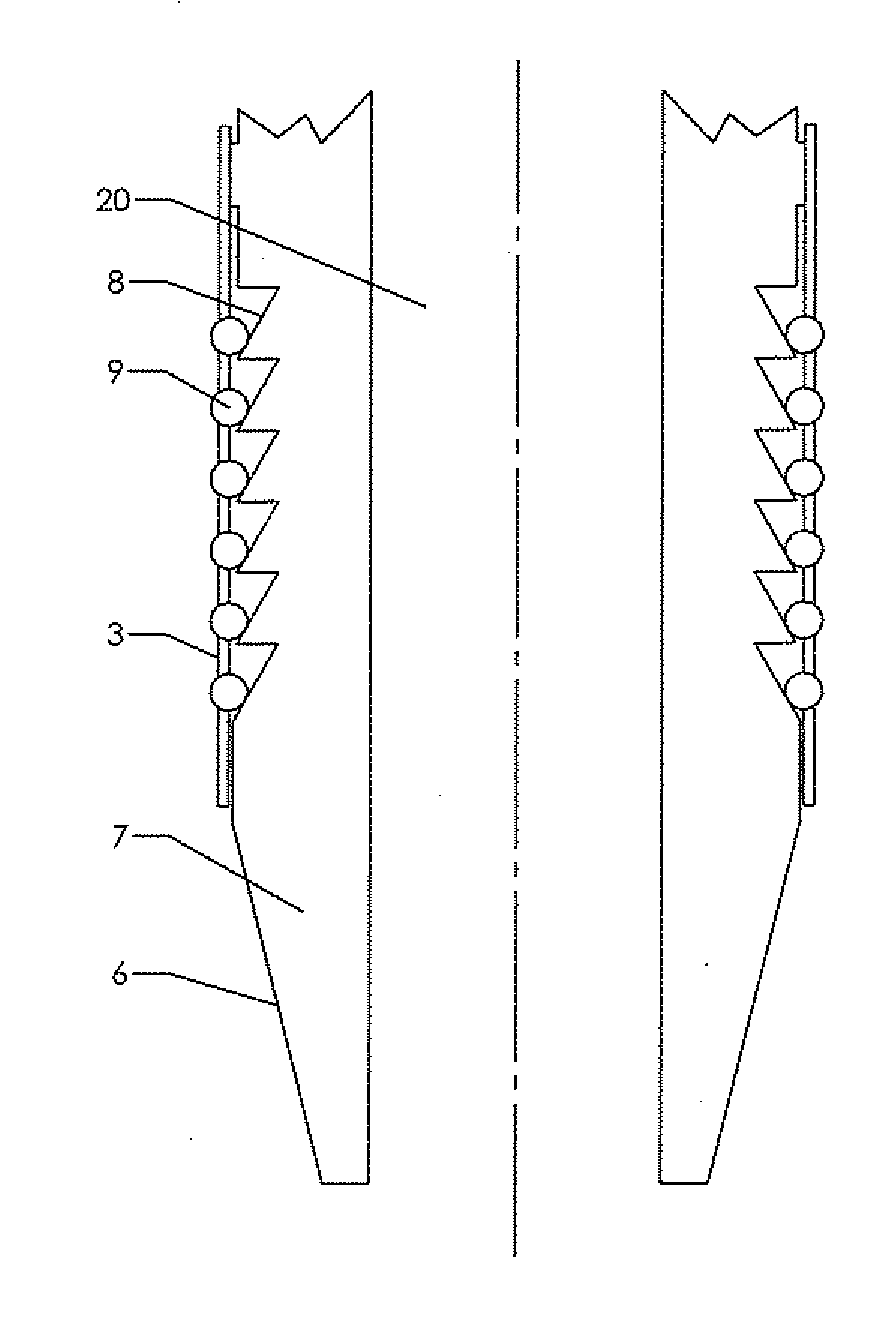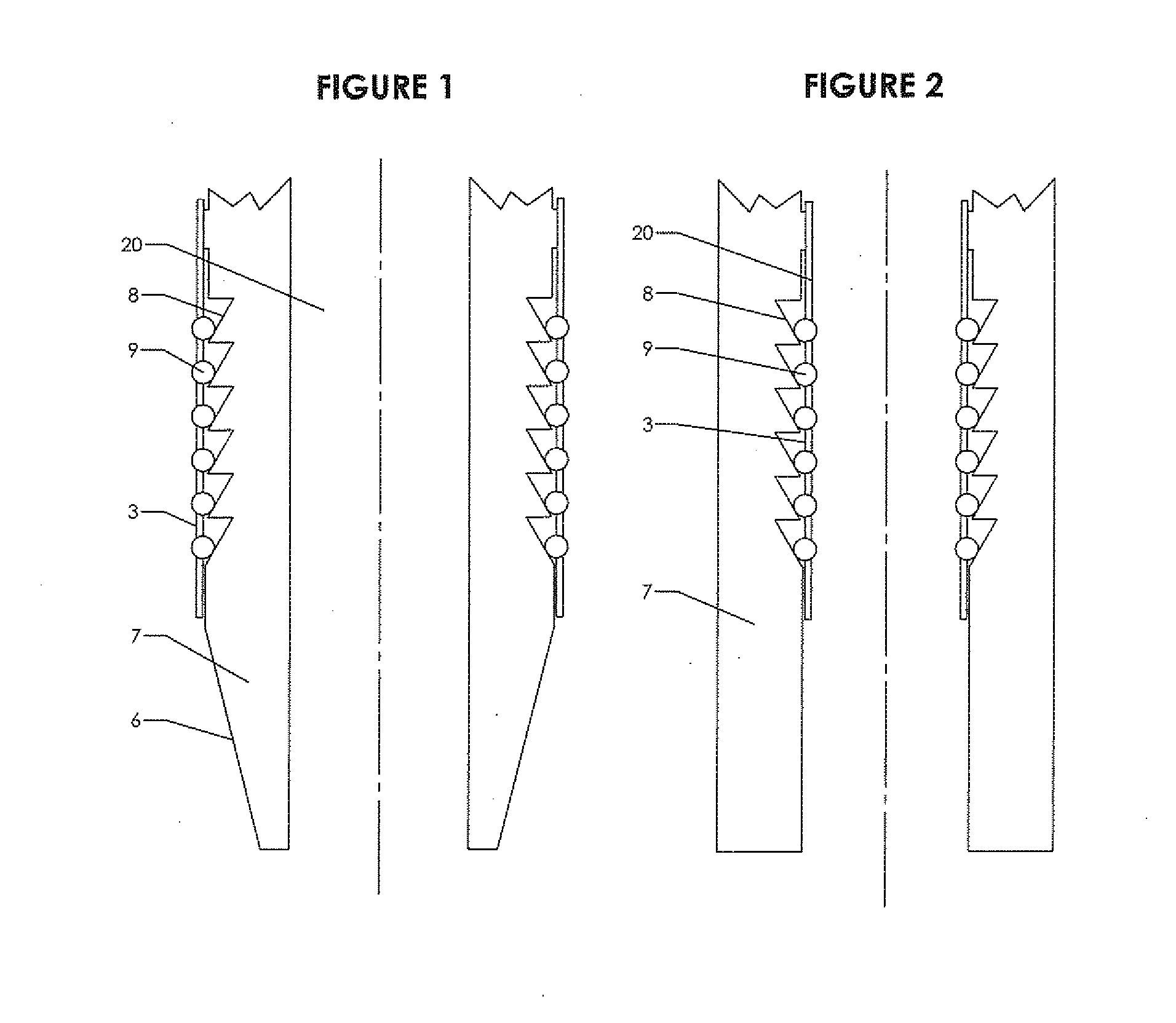It is also a very dangerous task with personnel often having to be located on a small platform suspended up to 50 feet from the rotary table or drilling rig floor and the power tong tethered to a steel cable under high loads.
Where a
top drive system is used to make up the connection, the use of a slip type
elevator to restrain the section of tubular OCTG to be added may be problematic, due to the configuration of the
top drive apparatus on the drilling platform.
While this is an advancement over the traditional approach as it requires substantially less equipment, it does however have serious drawbacks in the form of potential damage it may cause to the outer or inner surface of the tubular OCTG.
These grapple / dies also tend to be very sensitive to varying changes in tubular weight and diameters and therefore require a large resource of alternative sizes for each tubular OCTG size or weight to be run.
The possibility of loading one side of the tubular OCTG can present serious consequences for the integrity of the tubular OCTG and its ability to withstand down-hole pressures in the borehole.
This in turn may also result in
premature failure of the grapple / dies or impede their ability to act correctly on the tubular OCTG.
Thirdly, as the grapple / dies tend to be suspended on the outside of the member for internal gripping tools with no means of constraint they can become a huge safety issue if the rotational drive is engaged whilst the probe is not inside the tubular OCTG.
The centrifugal forces cause the grapple / dies to separate from the tool member, causing them to become entangled in the steel framework of the rig and potentially becoming dangerous objects falling from the derrick structure.
Fourthly, traditional methods of
tool design permits the slip assemblies, bodies or inserts to potentially friction bond or become adhered to each other under
heavy load conditions.
If these slip assemblies, bodies or inserts become frictionally adhered, this can cause serious problems, especially in a
well control situation.
When it comes to handling tubulars OCTG's where a single connector is used the failure of this single connector has the potential for catastrophic consequences.
A first
disadvantage of previous attempts is in the design of the member containing the inclined or tapered ramps which include areas of deeper than necessary pockets as well as sharp corners.
A second
disadvantage of previous attempts is that they were ineffective in providing the rotational torque capacity required for the make-up or break-out of said tubular OCTG.
This method of energizing the balls or rolling elements is ineffective in applying an adequate amount of preload force on the balls or rolling elements to create an indentation of sufficient size and depth to apply the required torque without slipping.
These designs do not allow the operator the ability to hydraulically, pneumatically, or mechanically control these preload forces to create the required indentations for applying torque.
A third
disadvantage of this previous attempts is in the design of the openings or slots and its role in applying torque.
Previous attempts cage housing openings make no attempt to aid in the application of torque.
A fourth disadvantage of this previous attempts is the use of elongated slots where the length of the slot is substantially longer than the
diameter of the ball or rolling element.
A fifth disadvantage of these elongated slots is the large cavity created between the elongated slots and the inclined surfaces.
This cavity may become filled with debris or other materials than can inhibit or prevent the function of the gripping device.
A sixth disadvantage of the elongated slot design is that the slot must contain a means of retaining the ball or rolling element along the longer sides of the slot because the ball or rolling element must be allowed to travel the entire length of the slot.
This aspect of the design prevents the sides or edges of a rolling element to protrude from the cage housing which limits the options for the shape of the rolling element.
The shape of the rolling element can also limit the range of outer or inner surface diameters which can be gripped with a given gripping device configuration.
A seventh disadvantage of the elongated slots is amount of material that is removed from the cage housing diminishing the
structural integrity of the cage housing.
Transporting tools to or from a drilling rig, loading, and unloading of these tools, especially on an offshore location, as well as handling of these tools can create damages.
A eighth disadvantage of previous attempts is the means of disengaging or releasing an internal gripping device during entry into a tubular whereby frictional forces acting upon the outer surface of the cage housing imposed from the internal surface of the tubular act to urge the cage housing in a direction such that the rolling elements move toward the deep end of the inclined surfaces, thus released position.
This “dragging” of the cage housing produces wear on the cage housing as well as the internal surface of the tubular.
This dragging can also cause damage to the internal tubular threads.
A ninth disadvantage of previous attempts is in the design of the member containing the inclined or tapered ramps which include areas of deeper than necessary pockets as well as sharp corners.
These sharp corners also create areas prone to
corrosion and or rusting.
A tenth disadvantage of previous attempts is in the use of multiple components such as small springs, plungers, inserts, biasing devices, etc which are all made unnecessary by the embodiments of the present invention.
All of these components must be held in place via means such as press fitting, adhesives, threaded fasteners, etc. which all initiate the potential for failures.
It is well known that as the number of parts is increased for a single mechanical device so does the
odds of failure.
The corresponding
machining or manufacturing processes for these components is greatly complicated by the use of these components.
The complexity and tight tolerances required to successfully manufacture these components substantially increases the overall cost of the gripping device.
An eleventh disadvantage of previous attempts again in the use of multiple components such as small springs, plungers, inserts, biasing devices, etc is that should any of these small components become loose or free from constraint, they can potentially fall into the
wellbore.
This potential is very high due to the jarring and shock loads the gripping device will experience in service as well as transport.
These shock loads can loosen threaded fasteners or other means of retention.
Should any of these components become free from constraint, the elongated slots will allow these items to depart from the assembly, thereby becoming major safety hazards with the potential for serious damage to personnel or structures from
flying debris.
Materials or items which unintentionally fall into the
wellbore create an array of very costly problems.
A twelfth disadvantage of the previous attempts utilizing the aforementioned inserts which are press fit or otherwise attached to the member containing the inclined surfaces is in the
non destructive testing of these components after each use in the field.
Components which are press fit or adhered using adhesives are generally very difficult or impossible to remove for inspection purposes.
This means that these parts will likely not be removed thereby possibly hiding a crack or damage.
 Login to View More
Login to View More  Login to View More
Login to View More 


